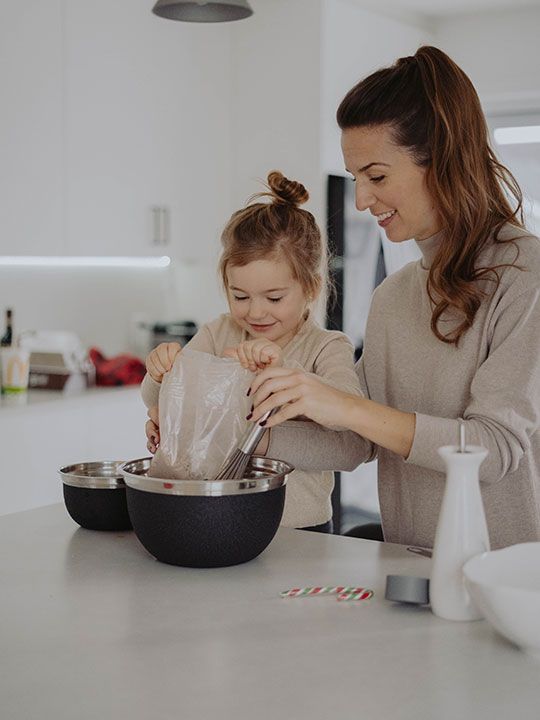
Of all the legacies you deign to give your child perhaps the most common – and least wanted – is a fear of mathematics.
As per an article published in ‘Harvard Business Review’ 93 per cent of Americans report experiencing some level of maths anxiety. And according to a Programme for International Student Assessment in 2012, across the 34 participating Organisation for Economic Co-operation and Development (OECD) countries, 59 per cent of the 15- to 16-year-old students said they worry about the perceived difficulty of maths classes while 33 per cent said number-crunching homework stressed them out and 31 per cent admitted to feeling nervous when confronted by a maths problem.
ALSO READ
Hiba Mehanna, Wellness Consultant and General Manager of Miracles Dubai, explains that the insecurities children face around maths can stem anywhere from societal and family pressures to perform well, to not being able to meet the set standards that peers can reach which can result in being teased by other kids in the school environment. “Children that have received poor maths grades in the past can develop an insecurity towards the subject due to a fear of repeated results, and this insecurity can create an inaccurate belief that they are simply ‘not good at maths’.”
Benjamin Atkins, Head of Secondary at The Aquila School, also says maths makes for an easy target. “People find it acceptable to publicly acknowledge that 'I was not good at maths at school' and 'I don't like maths’, but would never openly say the same about reading or other subjects. This gives many pupils a false view of what mathematics in secondary school could be like before they even attend their first class,” he explains.
How does anxiety work in kids?
Anxiety around a subject is a learned behaviour. Mehanna explains that in a child's brain at a neuroscientific level, one can see that neural pathways are at their peak in forming strong connections. “These connections, if continuously used form a neural pattern that results in a future set behaviour. A perfect example is a child who goes to school and has a negative experience in the classroom, if this is a one-time event, the child will feel the negative emotion (shame, embarrassment, etc.). However, it will not form a strong neural pathway and over time it will begin to dissipate. However, if the same child is consistently facing a negative emotion when they are in the classroom, this will create a strong neural pathway that will result in anxiety whenever they're put in a classroom setting as a child and even into adulthood.

The physical impact
“Although anxiety shows up in children due to repeated neural connections, it can also manifest physically as a sore tummy, headache, fatigue and lack of motivation. These manifestations of anxiety can also be a result of what is known as the gut-brain axis, simply put; your food creates your mood. Children displaying anxiety may bite their nails, fidget, have fluctuating emotions and have a hard time trying to concentrate. Further to this, they may not want to participate in social events, have a change of eating habits and suffer from disrupted sleep.”
Now for the good news. This isn’t a permanent state of affairs. You can subtract the worry from the situation by simply adding in a few elements such as a more conducive learning environment. “The good news is, in terms of maths insecurity and belief of self, it is possible to be reversed depending on the teaching method. This is evident by some children performing better in maths when they feel more connected to the teacher and the learning style of the school. It is important that a child who displays an insecurity in math be nurtured and understood in their way of learning, because when this is lacking it can result in an insecurity in how they process learning.”
* Bedwetting
* Behavioural changes i.e. being moody, aggressive, having temper tantrums, clingy behavior or frequent crying spells
* Complaints of aches and pains, most common being stomach aches or headaches
* Constant worrying or having negative thoughts
* Decreased or increased appetite
* Difficulty concentrating
* Fears, like a fear of the dark, being away from home or interacting with peers or strangers
* Sleep problems, waking in the night or having nightmares
* Struggling with or refusal to go to school
* Withdrawing from family or friends
A different intelligence
This is exactly what Paramjith Singh found out. The Indian expat’s ten-year-old son was so afraid of numbers that he would run off every time he’d see one. Fortunately, his school counselor spoke to him and realised the problem wasn’t maths, it was an aversion to two-dimensional numbers – he could not understand what they meant. A visualisation technique, where cups and bowls, oranges and apples were used to help the child physically see the difference in digits allowed him to learn them; today, he likes the subject, says Singh.

When it comes to teaching visualisation techniques, every activity can become a learning experience. “Other techniques at home could be to add mathematics into everyday activities - but especially cooking. Involving the child in a practical activity that focuses on weights and measure, but that can also look at ratio, is a great way to build family relationships and improve mathematics skills. Ask: ‘if we need 100g of flour for three people, how much do we need for six?’,” suggests Atkins.
Hareem Navaid, who teaches math and business at Dwight School Dubai, says it’s imperative to acknowledge the problem and then employ a few tried-and-tested strategies to overcome it.
“I teach my students stress management techniques. We do mindfulness exercises such as deep breathing, and meditation during mathematics lesson. These techniques help students to relax during any stressful situation,” she adds.
“The teacher should also make efforts in providing students the autonomy, competency and purpose for each learning objective to keep them motivated and engaged in learning,” she says.
In classrooms, one must also teach test-taking strategies, says Navaid. “Encourage them to solve the easiest questions first. To tackle the hard math word problem, students can draw the word problem to visualise the scenario.
“Encourage them to proactively break down large tasks into smaller more achievable and less stressful small tasks,” she adds.
And you can teach them tricks that will not only make the subject fun but easier to understand. Navaid offers the following hacks:
Adding Fractions: The easiest way to add fractions to 1 as a whole number is to add the numerator and denominator then replace the answer as the numerator value.
Subtraction using addition: A simpler way to subtract two values is to add up the tens and the units of the value of the two digit number. The answer after addition will be the result of subtraction of both given values.
Multiplying with 99: Subtract 1 from the first double digit number. Then subtract that answer from 99. Then write both answers together. It will be the product of multiplying any doubt digit number with 99
Point to shapes
Talk with your child about the shapes you see around you. Maybe on your walk together you notice a round stone or a square sign. “Look, the door on that house is a red rectangle!” Introducing these basic spatial sense skills – the concepts of shape, size, space and direction – will help your child later on in school when they start geometry.
Count it out
Find some small objects – such as shells or beads – to count together out loud. “Look! We have one, two, three, four, five orange beads.” You can also separate them into groups. “Let’s make three piles of three buttons.” This is a great way to introduce the concepts of numbers and operations (addition, subtraction, multiplication and division). You don’t only need objects to learn how to count – you could also work on counting with your little one by counting out loud how many steps they take or how many times they clap their hands.
Play a sorting game
Recognising patterns and relationships lays the foundation for learning equations later in life. To introduce these concepts to your toddler in a playful way, try playing a sorting game with objects around your house. “Let’s put the red lentils in one basket and the green lentils in the other basket.” You can also lay the objects out in a pattern. “Let’s make a row of lentils: red, green, red, green.”
Have fun in the kitchen
Cooking together is a great opportunity for your child to explore measurement and counting. Make sure to give them age-appropriate tasks and to supervise them closely while you create your culinary masterpiece! Talk about how much rice you need for your meal and show them how you measure it out. If you’re making a snack, count out the food items on your plate: “There are one, two, three, four berries in our snack.”
Build a tower
Stacking objects helps young children to learn about estimating size and understanding the relationship between different sized objects. To make a tower together, you could use blocks, empty boxes, empty cartons or other child-safe objects you have around the house that will stack well. Talk about how the pieces fit on top of one another and if the tower falls, why that happened. See how high you can go!
Compare and contrast
Take notice of the sizes of objects you see in comparison to one another. A market or food store are great places to do this together. “This mango is much bigger than that one.” You can also ask your child to point out which item they think is smaller or larger. This helps your toddler to work on building those important spatial sense and measurement skills.
Source: Unicef Parenting
The homework
Parents play a vital role in curing – or infecting – kids with math anxiety. Here are some ways you can help says Navaid.
• Check your attitude: Parents’ own attitude towards the mathematics also impact the children’s approach towards mathematics. Parents should not communicate any negative feelings about mathematics to their children.
• Do your prep work: Encourage time management and organisational skills. Help them to plan and prepare for test in advance.
• One report card grade doesn’t define a child. Your children are more than a grade on a report card. Praise and appreciate the effort, not only the final grade on the report card. Communicate it to your children also. One test won’t make or break the rest of her/his academic life or career.
• Remind your children about their strengths. Build their confidence by affirmations that “you can prepare for it”, “you can do this” or saying, “let’s do it together”. It brings the parents much closer to children and help improve parent child relationship which will help with anxiety as well.
• Tell them, it is easy to improve mathematical skills. Give your children confidence that he/she can improve her math ability by practicing.
• Encourage children to write down emotions. Studies have shown that writing down negative emotions reduces the severity of those emotions.
• Encourage a healthy lifestyle. “Structured bed times allow for enough time for the brain to rest, nurtured learning environments to avoid negative feelings that can result in fixed neural connections, and a healthy diet to feed the gut the vitamins and minerals essential to nourish the brain and its electrical output which we understand as emotions. In doing so not only can you reduce the level of anxiety displayed in a child but, you can also help them to build healthier fixed neural connections that will benefit them all the way into adulthood,” adds Mehanna.
A slow and steady approach to teaching math is sure to balance the numbers.
Have an issue you'd like answered? Write to us at parenting@gulfnews.com








